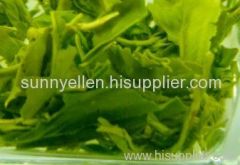.jpg)
Green Tea Extract
Company Profile
| Location: | Changsha, Hunan, China (Mainland) |
|---|---|
| Business Type: | Manufacturer |
Product Description
Botanical name:camellia sinensis
Specification: 98% polyphenols / 80% catechins / <1% caffeine ; 99% polyphenols / 85% catechins / <0.5% caffeine ; 85% catechins / 50% EGCG/ <1% caffeine ; 85% catechins / 60% EGCG/ <0.5% caffeine ; 80% EGCG ; 90% EGCG ; 95% EGCG ; 99% EGCG ; 20% L-theanine ; 30% L-theanine ; 98% L-theanine ; 20% polysaccharides
Parts used and uabitat: All teas (green, black and oolong) are derived from the same plant, Camellia sinensis. The difference is in how the plucked leaves are prepared. Green tea, unlike black and oolong tea, is not fermented, so the active constituents remain unaltered in the herb. The leaves of the tea plant are used both as a social and medicinal beverage. The plant does not originate in the wild. It was originally cultivated in China and is grown as a tea lant today in India, China, Sri Lanka, Japan, Indonesia, Kenya, Turkey, Pakistan, Malawi and Argentina.
Indications and usage:
(1) Atherosclerosis; Cancer risk reduction; Gingivitis (periodontal disease); High cholestero.
(2) Crohn is disease; Hemochromatosis (iron overload); High triglycerides; Hives; Immune function; Infection; Weight loss
Historical or traditional use: According to Chinese legend, tea was discovered accidentally by an emperor 4,000 years ago. Since then, traditional Chinese medicine has recommended green tea for headaches, body aches and pains, digestion, depression, immune enhancement, detoxification, as an energizer, and to prolong life. Modern research has confirmed many of these health benefits
Actions and pharmacology: Green tea contains volatile oils, vitamins, minerals, and caffeine, but the active constituents are polyphenols, particularly the catechin called epigallocatechin gallate (EGCG). The polyphenols are believed to be responsible for most of green tea is roles in promoting good health. Green tea mildly guards against cardiovascular disease in many ways. Green tea lowers total cholesterol levels and improves the cholesterol profile, reduces platelet aggregation, and lowers blood pressure. Several animal and test tube studies have demonstrated an anticancer effect of polyphenols from green tea. The polyphenols in green tea have also been associated with reduced risk of several types of cancer in humans. In a double-blind study, people with leukoplakia (a pre-cancerous oral condition) took 3 grams of mixed oral and topical green tea or placebo for 6 months. Those in the green tea group had significant decreases in the pre-cancerous condition compared to placebo. Green tea polyphenols have been shown to stimulate the production of several immune system cells, and have antibacterial properties even against the bacteria that cause dental plaque.







.gif)
